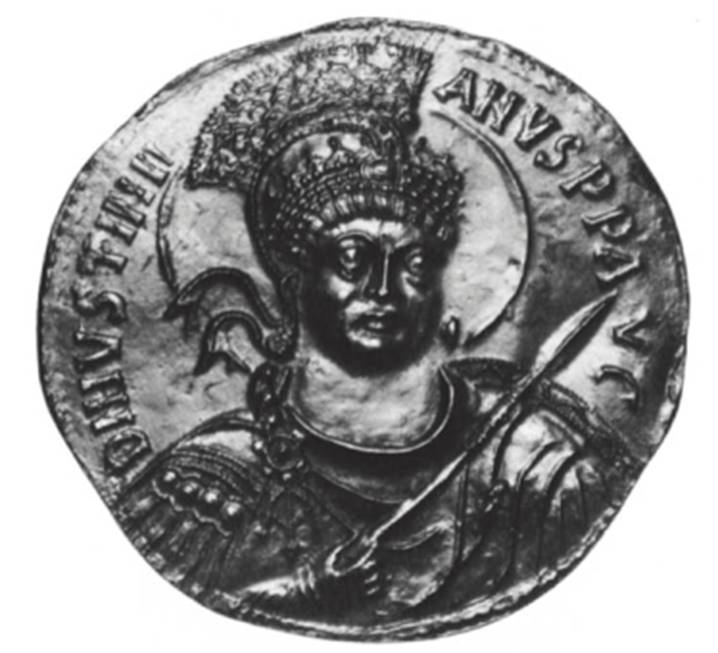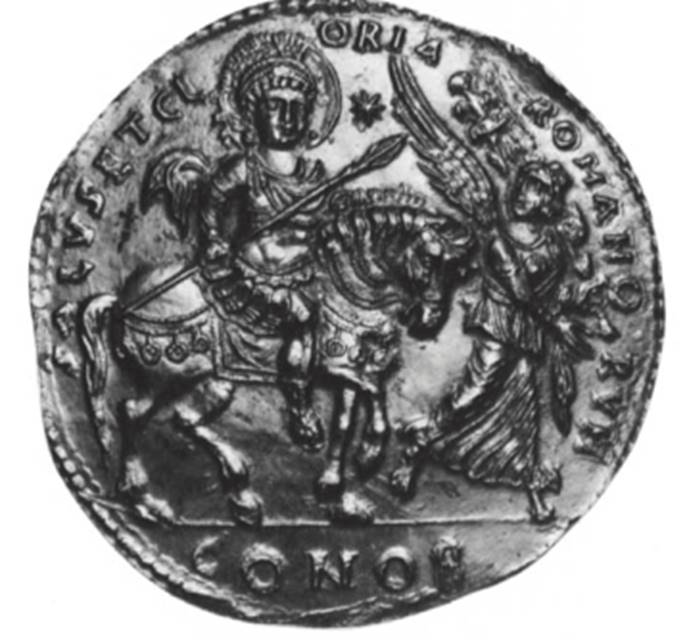Medallion of Justinian I. Constantinople, 534-538. Gold
obv: dn ivstinii anvs ppavc (Dominus noster Justinianus Perpetuus Augustus). Bust of Justinian nimbed, three-quarters right in military costume: elaborate helmet with plume and crest of peacock feathers, and jeweled diadem; paludamentum fastened at right shoulder with jeweled brooch, covering cuirass; spear in right hand, shield behind left shoulder.
rev: salvs et cloria romano rvm. Justinian nimbed in same costume, mounted on richly caparisoned horse riding right preceded by winged Victory holding palm branch and trophy over left shoulder. In field, star; in exergue, conob


Weighing fully one-half a Byzantine pound, this gold medallion may have been the last, as it is the most immense, of its kind. That it commemorates an important victory is obvious; which one is less clear. The slight turn of the emperor's body on the obverse corresponds with his coin portraits up to about 538, when a full-face image was substituted; the general period of the medallion seems likely to have been the mid-530s, the years of the great successes of Justinian's armies.
The portrayal of the emperor's regalia is remarkably rich, even when compared with large-scale depictions such as that in the famous donation mosaic panel at S. Vitale in Ravenna (no. 65); but the work as a whole is less than a complete success—coarse in detail and execution. Undoubtedly, the enormous size of the die stretched the capabilities of its cutter beyond his limits; the piece also proved difficult to strike, as the doubled "i" of the obverse inscription and the blurring of the Victory of the reverse betray.
Nevertheless, the gross likeness is closer to the portrait in S. Vitale than it first appears: while the S. Vitale face seems triangular in shape, the shadow of a generous double chin gives away what Procopius described as a face “round yet not uncomely" (Anecdota 8. 12 [Dewing, 1935, pp. 94-95]; his further reference to the similarity to Domitian may have been carefully chosen). The full curves and globular outlines of the medallic portrait conform to the geometric criteria of sixth-century portrait style as we know it from ivories and a few surviving portrait heads (cf. nos. 24-28).
The representation of the triumphant emperor has recalled to many scholars the description by Procopius of an equestrian statue erected by Justinian in the Augusteum at Constantinople; but, although the feathered headdress of the medallic image may qualify as the Persian-derived toupha (fig. 7), other aspects of the description differ. According to Procopius, the bronze Justinian held a globus cruciger in his left hand, extending his open right hand toward the rising sun [Aed. 1.2.5 ff.).
The unique medallion was discovered in 1751 at Caesarea (Kayseri) in Cappadocia and purchased soon after in Constantinople by the Count Desail- leurs, who presented it to the Royal Collection. In 1831 it was one of a number of pieces stolen from the Cabinet des Medailles and presumably melted down; it is known from casts taken by Mionnet before the theft, one of which appears here.
Bibliography: Babelon, 1896; Toynbee, 1944, pi. xlix, 3; Lehmann (1), 1959; Mango, 1959; Lehmann (2), 1959; Morrisson, 1970, I, p. 69, and pi. viii, 1 (misdated 524).
Date added: 2025-07-10; views: 158;
